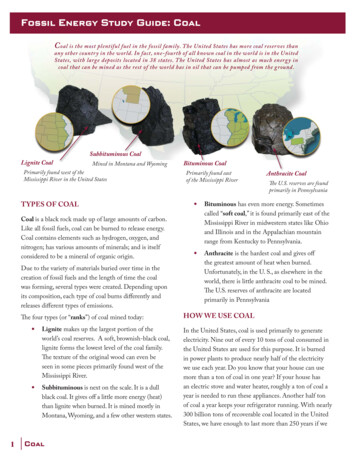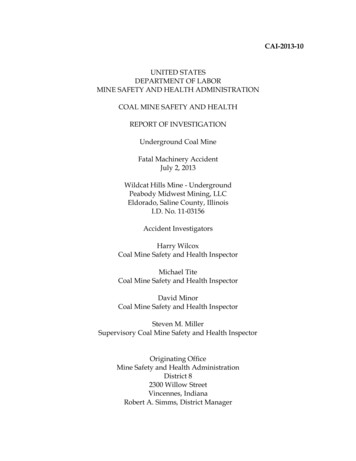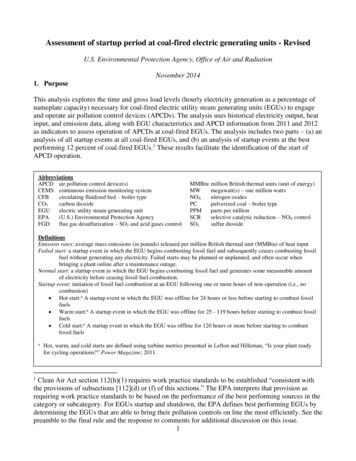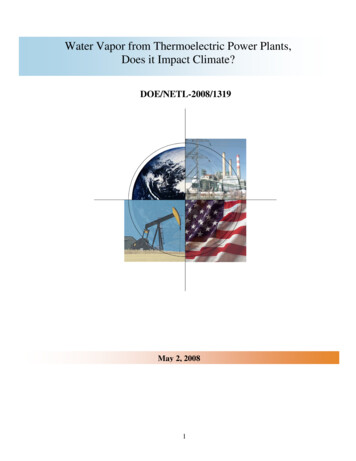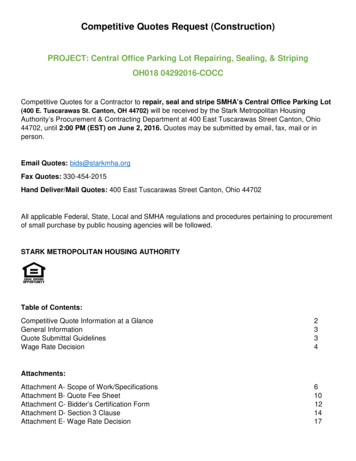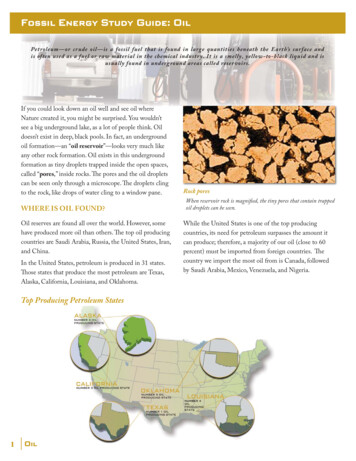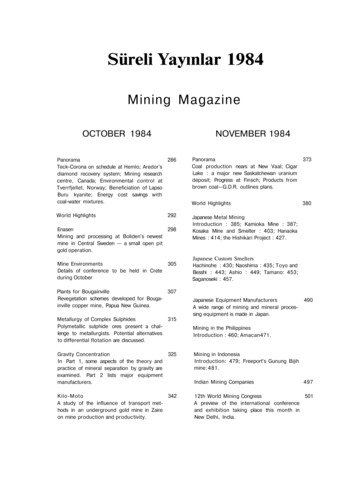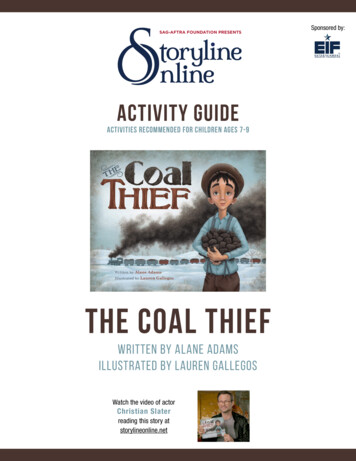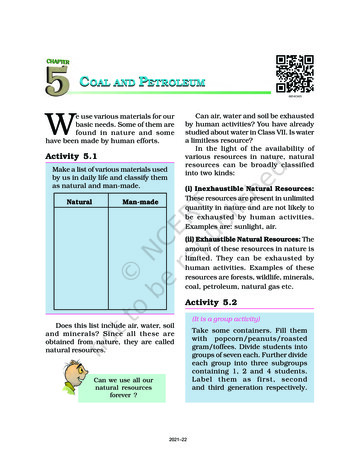
Transcription
COAL AND PETROLEUMWe use various materials for ourbasic needs. Some of them arefound in nature and somehave been made by human efforts.Activity 5.1Make a list of various materials usedby us in daily life and classify themas natural and man-made.NaturalCan air, water and soil be exhaustedby human activities? You have alreadystudied about water in Class VII. Is watera limitless resource?In the light of the availability ofvarious resources in nature, naturalresources can be broadly classifiedinto two kinds:(i) Inexhaustible Natural Resources:These resources are present in unlimitedquantity in nature and are not likely tobe exhausted by human activities.Examples are: sunlight, air.Man-made(ii) Exhaustible Natural Resources: Theamount of these resources in nature islimited. They can be exhausted byhuman activities. Examples of theseresources are forests, wildlife, minerals,coal, petroleum, natural gas etc.Activity 5.2(It is a group activity)Does this list include air, water, soiland minerals? Since all these areobtained from nature, they are callednatural resources.Can we use all ournatural resourcesforever ?2021–22Take some containers. Fill themwith popcorn/peanuts/roastedgram/toffees. Divide students intogroups of seven each. Further divideeach group into three subgroupscontaining 1, 2 and 4 students.Label them as first, secondand third generation respectively.
5.1 CoalThese sub-groups represent theconsumers. As population isgrowing, second and thirdgenerations have larger number ofconsumers.Put one full container for eachgroup on a table. Ask consumers ofthe first generation from each groupto consume eatables from thecontainer of their group. Now, askthe second generation consumersfrom each group to do the same. Askstudents to observe carefully theavailability of eatables in eachcontainer. If some thing is left in thecontainers, ask third generationfrom each group to consume it. Now,finally observe whether all theconsumers of the third generationgot the eatables or not. Also observeif anything is still left in any of thecontainers.You may have seen coal or heard aboutit (Fig. 5.1). It is as hard as stone and isblack in colour.Fig. 5.1: CoalCoal is one of the fuels used to cookfood. Earlier, it was used in railwayengines to produce steam to run theengine. It is also used in thermal powerplants to produce electricity. Coal is alsoused as a fuel in various industries.Story of CoalAssume that the eatables in thecontainer represent the totalavailability of an exhausible naturalresource like coal, petroleum ornatural gas. Each group may have adifferent consumption pattern. Arethe earlier generations of any grouptoo greedy? It may be that the earliergenerations in some groups wereconcerned about the cominggeneration(s) and left something forthem.In this chapter we will learn aboutsome exhaustible natural resourceslike coal, petroleum and natural gas.These were formed from the deadremains of living organisms (fossils).So, these are all known as fossilfuels.Where do we getcoal from and howis it formed?About 300 million years ago theearth had dense forests in low lyingwetland areas. Due to natural processes,like flooding, these forests got buriedunder the soil. As more soil depositedover them, they were compressed. Thetemperature also rose as they sankdeeper and deeper. Under high pressureand high temperature, dead plants gotslowly converted to coal. As coalcontains mainly carbon, the slowprocess of conversion of dead vegetationinto coal is called carbonisation. Sinceit was formed from the remains ofvegetation, coal is also called a fossil fuel.A coal mine is shown in Fig. 5.2.57COAL AND PETROLEUM2021–22
Fig. 5.2: A coal mineWhen heated in air, coal burns andproduces mainly carbon dioxide gas.Coal is processed in industry to getsome useful products such as coke, coaltar and coal gas.CokeIt is a tough, porous and blacksubstance. It is an almost pure form ofcarbon. Coke is used in the manufactureof steel and in the extraction of manymetals.about 200 substances. Productsobtained from coal tar are used asstarting materials for manufacturingvarious substances used in everydaylife and in industry, like syntheticdyes, drugs, explosives, per fumes,plastics, paints, photographic materials,roofing materials, etc. Interestingly,naphthalene balls used to repel mothsand other insects are also obtained fromcoal tar.These days, bitumen, a petroleumproduct, is used in place of coal-tarfor metalling the roads.Coal TarIt is a black, thick liquid (Fig. 5.3) withan unpleasant smell. It is a mixture ofCoal GasCoal gas is obtained during theprocessing of coal to get coke. It is usedCoal gas was used for street lightingfor the first time in London in 1810and in New York around 1820. Now adays, it is used as a source of heatrather than light.Fig. 5.3: Coal tar58SCIENCE2021–22
as a fuel in many industries situatednear the coal processing plants.5.2 PetroleumYou know that petrol is used as a fuel inlight automobiles such as motor cycles/scooters and cars. Heavy motor vehicleslike trucks and tractors run on diesel.Petrol and diesel are obtained from anatural resource called petroleum. Theword petroleum is derived from petra(rock) and oleum (oil) as it is minedfrom between the rocks under Earth asshown in Fig. 5.4.Do you know how petroleum isformed?Petroleum was formed fromorganisms living in the sea. As theseorganisms died, their bodies settled atthe bottom of the sea and got coveredwith layers of sand and clay. Overmillions of years, absence of air, hightemperature and high pressuretransformed the dead organisms intopetroleum and natural gas.Look at Fig. 5.4. It shows the depositsof petroleum and natural gas. You seethat the layer containing petroleum oiland gas is above that of water. Why is itso? Recall that oil and gas are lighterthan water and do not mix with it.The world’s first oil well was drilledin Pennsylvania, USA, in 1859. Eightyears later, in 1867, oil was struckat Makum in Assam. In India, oil isfound in Assam, Gujarat, MumbaiHigh and in the river basins ofGodavari and Krishna.Refining of PetroleumPetroleum is a dark oily liquid. It hasan unpleasant odour. It is a mixture ofvarious constituents such as petroleumgas, petrol, diesel, lubricating oil,paraffin wax, etc. The process ofWellsImperviousrockGasOilReservoir rockWaterFig. 5.4 : Petroleum and natural gas deposits59COAL AND PETROLEUM2021–22
Various constituents of petroleumand their uses are given in Table 5.1.Many useful substances are obtainedfrom petroleum and natural gas.These are termed as ‘Petrochemicals’.These are used in the manufactureof detergents, fibres (polyester, nylon,acrylic etc.), polythene and otherman-made plastics. Hydrogen gasobtained from natural gas, is used inthe production of fertilisers (urea).Due to its great commercialimportance, petroleum is also called‘black gold’.5.3 Natural GasFig. 5.5: A petroleum refineryseparating the various constituents/fractions of petroleum is known asrefining. It is carried out in a petroleumrefinery (Fig. 5.5).Natural gas is a very important fossilfuel because it is easy to transportthrough pipes. Natural gas is storedunder high pressure as compressednatural gas (CNG). CNG is used forpower generation. It is now being usedTable 5.1 Various Constituents of Petroleum and their UsesS.No.1.Constituents of PetroleumPetroleum Gas in Liquid formUsesFuel for home and industry(LPG)2.PetrolMotor fuel, aviation fuel, solvent fordry cleaning3.KeroseneFuel for stoves, lamps and for jet aircrafts4.DieselFuel for heavy motor vehicles, electricgenerators5.Lubricating oilLubrication6.Paraffin waxOintments, candles, vaseline etc.7.BitumenPaints, road surfacing60SCIENCE2021–22
as a fuel for transport vehicles becauseit is less polluting. It is a cleaner fuel.The great advantage of CNG is thatit can be used directly for burning inhomes and factories where it can besupplied through pipes. Such a networkof pipelines exists in Vadodara (Gujarat),some parts of Delhi and other places.Natural gas is also used as a startingmaterial for the manufacture of a numberof chemicals and fertilisers. India has vastreserves of natural gas. In our country,natural gas has been found in Tripura,Rajasthan, Maharashtra and in theKrishna Godavari delta.Can coal, petroleumand natural gas beprepared in thelaboratory from deadorganisms?No. Theirformation is a veryslow process andconditions fortheir formationcannot be createdin the laboratory.5.4 Some Natural Resourcesare LimitedYou have studied in the beginning ofthe chapter that some natural resourcesare exhaustible like fossil fuels, forests,minerals etc.You know that coal and petroleumare fossil fuels. It required the deadorganisms millions of years to getconverted into these fuels. On theother hand, the known reserves ofthese will last only a few hundredyears. Moreover, burning of thesefuels is a major cause of air pollution.Their use is also linked to globalwarming. It is therefore necessary thatwe use these fuels only whenabsolutely necessary. This will resultin better environment, smaller risk ofglobal warming and their availabilityfor a longer period of time.In India, the Petroleum ConservationResearch Association (PCRA) advisespeople how to save petrol/diesel whiledriving. Their tips areldrive at a constant and moderatespeed as far as possible,lswitch off the engine at traffic lightsor at a place where you have to wait,lensure correct tyre pressure.lensure regular maintenance of thevehicle.61COAL AND PETROLEUM2021–22
KEYWORDSWHAOU HAVE LEARNTWHATYOUHAVET YCOALÜCoal, petroleum and natural gas are fossilfuels.COAL GASÜCOAL TARFossil fuels were formed from the dead remainsof living organisms millions of years ago.COKEÜFossil fuels are exhaustible resources.ÜCoke, coal tar and coal gas are the productsFOSSIL FUELof coal.ÜNATURAL GASPetroleum gas, petrol, diesel, kerosene,paraffin wax, lubricating oil are obtained byPETROLEUMrefining petroleum.ÜPETROLEUMCoal and petroleum resources are limited. Weshould use them judiciously.REFINERYExercises1.What are the advantages of using CNG and LPG as fuels?2.Name the petroleum product used for surfacing of roads.3.Describe how coal is formed from dead vegetation. What is this processcalled?4.Fill in the blanks.5.6.,and.(a)Fossil fuels are(b)Process of separation of different constituents from petroleum iscalled.(c)Least polluting fuel for vehicle is.Tick True/False against the following statements.(a)Fossil fuels can be made in the laboratory.(T/F)(b)CNG is more polluting fuel than petrol.(T/F)(c)Coke is almost pure form of carbon.(T/F)(d)Coal tar is a mixture of various substances.(T/F)(e)Kerosene is not a fossil fuel.(T/F)Explain why fossil fuels are exhaustible natural resources.62SCIENCE2021–22
EXERCISES7.Describe characteristics and uses of coke.8.Explain the process of formation of petroleum.9.The following Table shows the total power shortage in India from1991–1997. Show the data in the form of a graph. Plot shortage percentagefor the years on the Y-axis and the year on the X-axis.S. No.YearShortage 27199711.5Extended Learning — Activities and Projects1.Get an outline map of India. Mark the places in the map wherecoal, petroleum and natural gas are found. Show the places wherepetroleum refineries are situated.2.Choose any five families of your neighbourhood. Enquire whethertheir energy consumption (coal, gas, electricity, petrol, kerosene)has increased or decreased in the last five years. Enquire also aboutthe measures they adopt to conserve energy.3.Find out the location of major thermal power plants in India. Whatcould be the reasons for their being located at those places?For more information, lweb.pcra.org63COAL AND PETROLEUM2021–22
gas, petrol, diesel, lubricating oil, paraffin wax, etc. The process of Fig. 5.4 : Petroleum and natural gas deposits The world’s first oil well was drilled in Pennsylvania, USA, in 1859. Eight years later, in 1867, oil was struck at Makum in Assam. In India, oil is found in Assam, Gujarat
